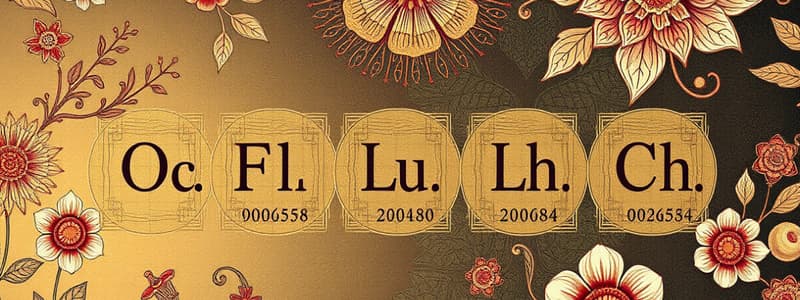Podcast
Questions and Answers
Name the compound: NF3
Name the compound: NF3
Nitrogen Trifluoride
What is the chemical formula for Iron (III) Oxide?
What is the chemical formula for Iron (III) Oxide?
Fe2O3
What are the rules for uncommon oxidation numbers?
What are the rules for uncommon oxidation numbers?
- Figure out what the symbols for each element are. 2. Assign oxidation numbers - metal>roman numeral, nonmetal>periodic table. 3. Cross-multiply oxidation numbers. 4. Reduce if needed.
What is a compound?
What is a compound?
What is an oxidation number?
What is an oxidation number?
If the formula is an ionic bond, a metal will join with a nonmetal or a metal with another metal.
If the formula is an ionic bond, a metal will join with a nonmetal or a metal with another metal.
If the formula is covalent, a nonmetal will join with a nonmetal.
If the formula is covalent, a nonmetal will join with a nonmetal.
What is the chemical formula for Sodium Chloride?
What is the chemical formula for Sodium Chloride?
What is the chemical formula for Iron (III) Nitride?
What is the chemical formula for Iron (III) Nitride?
What is the chemical formula for Calcium Nitride when Ca + N react?
What is the chemical formula for Calcium Nitride when Ca + N react?
What is the chemical formula for Chromium Phosphide when Cr + P react?
What is the chemical formula for Chromium Phosphide when Cr + P react?
Name some properties of ionic compounds.
Name some properties of ionic compounds.
What is the chemical formula for Dinitrogen Trioxide?
What is the chemical formula for Dinitrogen Trioxide?
What is the chemical formula for Carbon Monoxide?
What is the chemical formula for Carbon Monoxide?
What is the common name for F4O2?
What is the common name for F4O2?
Study Notes
Compounds and Their Definitions
- NF3 is known as Nitrogen Trifluoride, a compound with nitrogen and fluorine.
- Iron (III) Oxide has the chemical formula Fe2O3, indicating its oxidation state.
- A compound forms when two or more elements chemically combine, resulting in a new substance.
Oxidation Numbers
- Oxidation numbers help determine how many electrons an atom gains or loses during compound formation.
- To assign oxidation numbers: identify element symbols, assign based on Roman numerals for metals and the periodic table for nonmetals.
- Follow a crisscross method for oxidation numbers, reducing only if necessary.
Types of Bonds
- Ionic bonds occur when metals bond with nonmetals or when metals bond with other metals, typically resulting in gaining or losing electrons.
- Covalent bonds form between nonmetals, where they share electrons.
Common Compounds and Their Formulas
- Sodium Chloride is represented by the formula NaCl.
- Iron (III) Nitride is denoted as Fe3N3, showcasing the combination of iron and nitrogen.
- Calcium nitride is represented as Ca3N2, formed from calcium and nitrogen.
- Chromium Phosphide has the formula Cr3P2, illustrating the bond between chromium and phosphorus.
- Dinitrogen Trioxide is expressed as N2O3, a compound with nitrogen and oxygen.
- Carbon Monoxide is represented by the formula CO, indicating a compound of carbon and oxygen.
- Tetrafluorine Dioxide is denoted as F4O2, indicating four fluorine atoms bonded to two oxygen atoms.
Properties of Ionic Compounds
- Ionic compounds typically form crystalline structures.
- They have high melting points due to strong electrostatic forces between ions.
- Ionic compounds can conduct electricity when dissolved in water or melted, allowing movement of ions.
Studying That Suits You
Use AI to generate personalized quizzes and flashcards to suit your learning preferences.
Description
This quiz covers essential concepts in chemistry, focusing on compounds, their definitions, oxidation numbers, and types of chemical bonds. Learn how to identify common compounds and understand their chemical formulas while exploring the significance of ionic and covalent bonds. Test your knowledge and strengthen your understanding of these foundational topics in chemistry.




